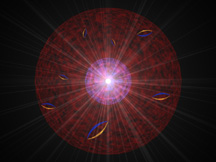 Purdue Newsmakers
Purdue Newsmakers 
 Purdue Newsmakers
Purdue Newsmakers 
Purdue News Service: (765) 494-2096; e-mail, purduenews@purdue.edu
January 31, 1997
Purdue faculty, staff and students make headlines around the world. This column offers highlights of those stories that appeared or were carried by national news media outside Indiana.

An electron may not be exactly what we've thought it was since its discovery 100 years ago. David Koltick , professor of physics, recently published research results showing that the electromagnetic force from the electron, or its electronic strength, may increase toward the particle's central core. Several publications carried or will carry articles on the research, including the Washington Post , Dallas Morning News , Popular Mechanics , Laser Focus World and Conocer , a Spanish science magazine. Koltick also was interviewed by German national radio. See news release.
Several radio programs featured interviews with Margaret Finders , assistant professor of English, on her new book, "Just girls, hidden literacies and life in junior high." The book is the result of a study in which Finders followed six junior-high girls for one year, reading everything they wrote and read. Broadcast interviews include: Family News Radio , carried by 1,400 public radio stations across the country; Best of Our Knowledge , syndicated nationally to 70 public radio stations; Associated Press radio network; 51 Percent , a program produced by WAMC public radio in Albany, N.Y.; and Prime Time Radio out of Washington, D.C. She also was interviewed by newspapers including the Baltimore Sun , Denver Post and Chicago Tribune , which planned to include a story in a publication it sends to high schools across the country. See news release.
Purdue engineering alumnus John Blaha had an excuse for not attending his daughter's graduation. He was orbiting the Earth in the Russian space station, Mir. He did, however, send a message that was played during the commencement ceremony in Elliott Hall of Music. Daughter Carolyn told the Associated Press: "It's been so long since I talked to him it brings a tear to my eye every time I hear his voice." The Sacramento (Calif.) Bee and the Hackensack (N.J.) Record were among the newspapers to carry the AP story.
Jeffrey Bennetzen , professor of biology, has found that corn is full of genetic hitchhikers that could weaken, kill or drastically alter the plant cells -- but don't. This extra genetic material, akin to retroviruses that cause disease in people, avoids damaging its host by keeping safely away from active genes that determine the plant's traits. In an Associated Press article, Bennetzen says, "If plants have retroviruses but don't have retroviral diseases, then they've figured out a way to beat the retrovirus. And animals haven't figured that out." Finding out why this happens could help scientists develop more efficient gene therapy techniques in humans. The story ran on the national Associated Press wire and appeared in papers including the Houston Chronicle and the Orange County (Calif.) Register . See news release
Plants that could resist many diseases may soon be possible thanks to research conducted by Gregory Martin , associate professor of agronomy, and similar research conducted by the University of California, Davis. Martin's research, which was published in December in Science , has shown that an enzyme called PTO kinase is the key, and that it is produced by resistant plants that have a gene-for-gene relationship with the invading microbes. Articles about his discovery and its possible applications appeared in The Sunday Times of London, The New York Times , The Los Angeles Times , and Denver's Rocky Mountain News . See news release.
Each harvest season, the celebration of the year's crop is marred by the news that another farmer or child has died by being entrapped in grain. A front-page story in the Wall Street Journal on the danger pointed out that research at Purdue has found that 92 percent of entrapments are fatal. More startling, according to William Field , professor of agricultural engineering who was quoted in the article, the average age of those killed from entrapments is 11 years old. See news release.
A recent Los Angeles Times article describes the current state of the use of robots in industry, and examines possible future trends. Avi Kak , professor of electrical engineering and director of the Robot Vision Laboratory, says that currently "Dumb robots are selling like hot cakes." While machines may never completely replace humans in manufacturing, Kak predicts that "As computers become more powerful at an amazing pace, in the near future sensor-based robots will become a reality and more manufacturing jobs will be automated." The London Daily Telegraph also carried the story.
Michael Staten , executive director of the Credit Research Center, recently testified before the National Bankruptcy Review Commission concerning the record 1.1 million bankruptcies filed last year. Staten cited research he has done indicating that 45 percent of people who filed for Chapter 7 bankruptcy protection had income, after expenses, to repay some of their debts. Staten's testimony was reported in an Associated Press story, which ran in papers including the Philadelphia Inquirer, the Minneapolis Star Tribune, Baltimore Sun and Cleveland Plain Dealer .
"Everyone talks about the weather, but on the Internet you can do something about it," states a Milwaukee Journal-Sentinel article that touted the Department of Earth and Atmospheric Science's Weather Processor (https://wxp.atms.purdue.edu) as among the best weather sites on the Web for looking up meteorological data such as forecasts for cities around the country and viewing weather-related images.
Eva Sevick-Muraca , assistant professor of chemical engineering, was featured recently on Turner Broadcasting (TBS) in a "Technology Update" segment aired during a break in the network's Thursday night movie. Sevick-Muraca discussed her research on using laser light for the early detection of disease. See news release.
You can help ensure that your school and faculty are recognized in "Newsmakers" by sending clips of national news stories or reports of national broadcasts to Jeanne Norberg, director, Purdue News Service, ENAD.